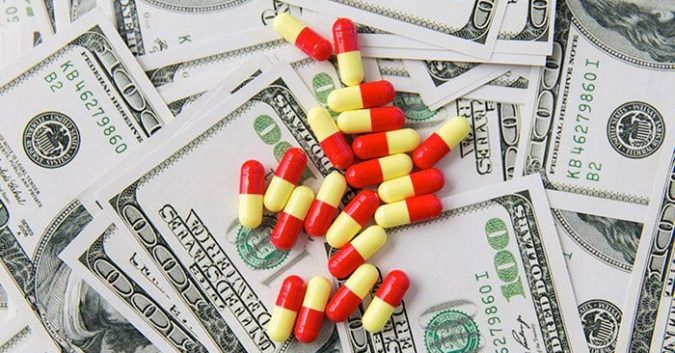For most Americans, the name Martin Shkreli is synonymous with something like loathsome fiend, or perhaps despicable scrooge of Big Pharma. In summer of 2015, the 33-year-old “Pharma Bro” caused uproar when his company, Turing Pharmaceuticals, raised the price of a life-saving HIV drug from $13.50 a tablet to $750 a tablet overnight. Shkreli was indifferent that patients depending on the drug would need to spend tens of thousands of dollars a year in order to survive, many of them going broke in the process.
Shkreli’s price gouging is by no means a stand-alone example of unethical business practice in the pharmaceutical industry. In fact, the greedy strategies of Turing Pharmaceuticals have more or less become the standard operating procedure in an industry where consideration of profit comes far before that of people. As a result, drug prices have soared in recent years, and often without explanation.
According to a recent study by IMS Health, list prices for drugs increased by 12 percent in 2015 alone, while patient cost exposure has increased 25 percent since 2010. Revenues, meanwhile, are skyrocketing: the IMS Health study estimates that by 2020, U.S. spending on medicines will reach $400 Billion.
As the colossal companies of Big Pharma run off with such astonishing profits, many consumers find themselves wondering: how the heck do these corporations arrive at the exorbitant prices for the drugs they sell?
Inelastic Demand: A Closer Look into the Price Gouge
The path a drug takes from manufacturer to patient is a complex route where many so-called “middlemen” are paid along the way. After being manufactured by a pharmaceutical company, the drug is sent to a distributor. The distributor pockets a fee and then delivers the drug to a pharmacy. The pharmacy skims off its own percentage before selling the medicine to the patient. If the patient is insured, a Pharmacy Benefit Manager receives payment for facilitating the transaction between the pharmacy and the insurer or employer.
So the drugs change hands many times over – and everyone is paid along the way.
Around 80 percent of all drugs sold in the U.S. are cheap, generic alternatives to brand-name drugs. That means that most people buying drugs are spending less than $10 on their purchase, and the purchases are often covered by insurance, anyway. However, if a patient has a more serious illness and needs a newer, more complex medicine, the only option may be to choose an expensive brand-name drug. Due to the exorbitant costs of these particular prescriptions, insurers have recently been making patients pay more and more of the cost themselves.
Demand for these more expensive drugs is “inelastic” – meaning no matter what changes occur to the price, the demand for the product does not change. If someone is seriously ill, they will pay whatever they need to in order to manage their illness, especially if it is a matter of life or death. Big Pharma recognizes this situation and exploits it by jacking up prices for specialty drugs. Case in point: Shkreli’s Daraprim®.
Consequently, the drugs that are the most desperately needed and have the least competition in the marketplace are the ones that become so unbelievably expensive.
A Sickening Trend
Besides Turing Pharmaceuticals, the industry is rife with examples of entrepreneurial firms that have bought out other drug companies and quickly hiked up drug prices by astonishing percentages. Gilead Sciences outraged millions by pricing a Hepatitis C treatment at $1,000 a daily tablet. The full 12-week course cost a patient $84,000, an amount more than double what the drug’s initial developer, Pharmasset, was planning on charging. What’s more, executives at Gilead admitted that they could make a significant profit selling the treatment at $55,000, yet they still chose to sell it for $84,000.
In 2015, Valeant Pharmaceuticals International bought the rights for 2 critically important heart drugs. On the same day, the list prices for the 2 drugs increased by 525 percent and 212 percent respective. The drugs themselves were in no way altered as a result of the price increase.
Both Gilead and Valeant have made handsome profits after increasing the prices of their-much needed drugs. This should come as no surprise – drug companies often walk away with profit margins unheard of in other industries. For example, in 2013 Pfizer had a mind-blowing 42 percent profit margin. That year the company reported over $51 Billion in sales, while it only spent $6 Billion on research and development.
Drug Companies in a Last-Minute Scramble before More Regulation Enacted
Some experts believe that drug prices are exploding as drug companies scramble to capitalize on the current free-market before government regulation changes the industry. Politicians are increasingly mentioning the need to regulate the pharmaceutical industry, perhaps most notably in the Democratic presidential primary.
It can only be hoped that the experts are right and that the regulation is indeed on the horizon for the pharmaceutical industry. This is likely the only means the business goals of the industry and the medical needs of the public can be reconnected. This is likely the only means to make the shameful profiteering come to an end.
